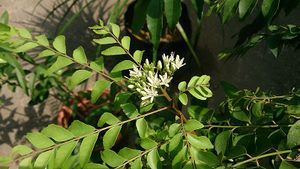Note: This is a project under development. The articles on this wiki are just being initiated and broadly incomplete. You can Help creating new pages.
Difference between revisions of "Murraya koenigii - Girinimba"
(→Commonly seen growing in areas) |
(→Parts Used) |
||
| Line 7: | Line 7: | ||
==Parts Used== | ==Parts Used== | ||
| − | {{Parts Used|Leaves}}, {{Parts Used| | + | {{Parts Used|Leaves}}, {{Parts Used|Roots}}, {{Parts Used|Crust}}, {{Parts Used|Fruits}}. |
==Chemical Composition== | ==Chemical Composition== | ||
Revision as of 10:47, 14 March 2019
Murraya koenigii belonging to Family Rutaceae which represent more than 150 genera and 1600 species. Murraya Koenigii is a highly values plant for its characteristic aroma and medicinal value. It is an important export commodity from India as it fetches good foreign revenue.
Contents
- 1 Uses
- 2 Parts Used
- 3 Chemical Composition
- 4 Common names
- 5 Properties
- 6 Habit
- 7 Identification
- 8 List of Ayurvedic medicine in which the herb is used
- 9 Where to get the saplings
- 10 Mode of Propagation
- 11 How to plant/cultivate
- 12 Commonly seen growing in areas
- 13 Photo Gallery
- 14 References
- 15 External Links
Uses
Cure Diarrhea, Gastrointestinal Protection, Cancer, Lower Cholesterol Levels, Hair Care, Eyesight, Pathogen Attack, Liver, Skin Care
Parts Used
Chemical Composition
Thirty-four compounds consisting of 97.4% of the oil were identified. The major constituents identified were α-pinene (51.7%), sabinene (10.5%), β-pinene (9.8%), β-caryophyllene (5.5%), limonene (5.4%), bornyl acetate (1.8%), terpinen-4-ol (1.3%), γ-terpinene (1.2%) and α-humulene (1.2%).[1]
Common names
| Language | Common name |
|---|---|
| Kannada | gandhabevu, kari-bevinagida |
| Hindi | Kari patta |
| Malayalam | Kareapela |
| Tamil | Karivepillai |
| Telugu | karepaku, karepeku |
| Marathi | NA |
| Gujarathi | NA |
| Punjabi | NA |
| Kashmiri | NA |
| Sanskrit | Alakavhaya, Chhardighna |
| English | Curry Leaf |
Properties
Reference: Dravya - Substance, Rasa - Taste, Guna - Qualities, Veerya - Potency, Vipaka - Post-digesion effect, Karma - Pharmacological activity, Prabhava - Therepeutics.
Dravya
Rasa
Tikta (Bitter), Kashaya (Astringent)
Guna
Laghu (Light), Ruksha (Dry), Tikshna (Sharp)
Veerya
Ushna (Hot)
Vipaka
Katu (Pungent)
Karma
Kapha, Vata
Prabhava
Habit
Identification
Leaf
| Kind | Shape | Feature |
|---|---|---|
| Simple | pinnate | The leaves are pinnate, with 11-21 leaflets, each leaflet 2-4 cm long and 1-2 cm broad |
Flower
| Type | Size | Color and composition | Stamen | More information |
|---|---|---|---|---|
| Unisexual | 2-4cm long | Yellow | 5-20 | The flowers are small white, and fragrant |
Fruit
| Type | Size | Mass | Appearance | Seeds | More information |
|---|---|---|---|---|---|
| simple | 7–10 mm | clearly grooved lengthwise, Lowest hooked hairs aligned towards crown | many | {{{6}}} |
Other features
List of Ayurvedic medicine in which the herb is used
- Vishatinduka Taila as root juice extract
Where to get the saplings
Mode of Propagation
How to plant/cultivate
Periodical hoeing and in the first year intercrop like pulses can be grown[3]
Commonly seen growing in areas
Tall grasslands, Meadows, Borders of forests and fields.
Photo Gallery
References
External Links
- Ayurvedic Herbs known to be helpful to treat Cure Diarrhea
- Ayurvedic Herbs known to be helpful to treat Gastrointestinal Protection
- Ayurvedic Herbs known to be helpful to treat Cancer
- Ayurvedic Herbs known to be helpful to treat Lower Cholesterol Levels
- Ayurvedic Herbs known to be helpful to treat Hair Care
- Ayurvedic Herbs known to be helpful to treat Eyesight
- Ayurvedic Herbs known to be helpful to treat Pathogen Attack
- Ayurvedic Herbs known to be helpful to treat Liver
- Ayurvedic Herbs known to be helpful to treat Skin Care
- Herbs with Leaves used in medicine
- Herbs with Roots used in medicine
- Herbs with Crust used in medicine
- Herbs with Fruits used in medicine
- Herbs with common name in Kannada
- Herbs with common name in Hindi
- Herbs with common name in Malayalam
- Herbs with common name in Tamil
- Herbs with common name in Telugu
- Herbs with common name in Sanskrit
- Herbs with common name in English
- Habit - Herb
- Index of Plants which can be propagated by Seeds
- Index of Plants which can be propagated by Cuttings
- Herbs that are commonly seen in the region of Tall grasslands
- Herbs that are commonly seen in the region of Meadows
- Herbs that are commonly seen in the region of Borders of forests and fields
- Herbs




